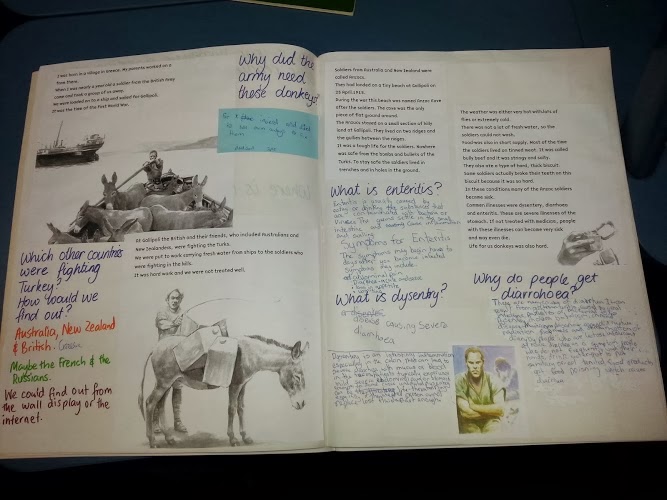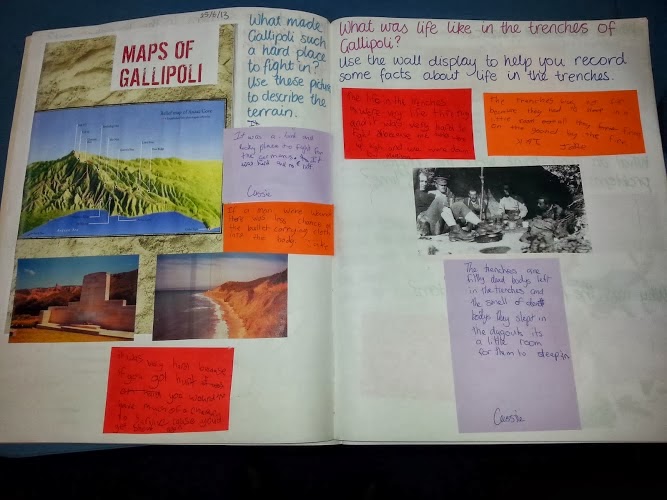In 2013 I decided for one reading group we would focus on this excellent picture book, The Donkey Man by Glyn Harper.
The hypotheses the group came up with did not mention war. In fact they thought it was going to be about a donkey on a farm!! So then I had to show them the actual book cover. When they saw the red cross on the bandage on the donkey's nose they had a better understanding.
So I gave them another go at the hypothesis (see the picture below) once they saw it in colour. Then we talked about what a blurb on the back cover was.
After discussing the blurb we then revisited our hypotheses to decide if they still stood up and then investigated where Gallipoli is.
I like to use maps, pictures, graphic organisers and other visual aids to give the children context as they read. The above maps that I used were a world map (giving context to where New Zealand is in comparison to Gallipoli); a map that focuses on the general area around Turkey (give context to neighbouring countries, especially on the fact that Britain wanted access to the Black Sea so Russia had a warm water port close to Europe); a map of Turkey (to see how big Turkey is in comparison to the area being fought over); and finally the map of the Gallipoli Peninsula to see where the attacks actually happened.
As you can see from the above picture, I used De Bono's thinking hats to get the group thinking about how the cover of the book impacts your impression. We learnt from starting with a black and white cover to going to a colour cover how your impression of the book changes. So by using De Bono's yellow/benefits thinking hat we discussed how having the coloured cover was able to help with making a hypothesis more so than the black and white cover; the colour gives so much more detail. Using the blurb also impacts on what you think about the story.
So before we have even started reading the text, there is a lot of discussion and prediction about the book. We have used a lot of visual aides too, to enable an understanding of where the events in this book are taking place and why.
I did photo copy the book and glue the story into the group's modelling book. I did this so we would be able to highlight aspects of text and to focus only on the pages that we were currently working on. I really did not want my original text drawn all over!! This also allowed me to ask questions pertaining to that particular piece of text.
As you can see above, this first lot of text talked about some of the more serious adverse conditions the soldiers faced at Gallipoli apart from bullets - disease. So I sent the kids off with the dictionary, i-pads and/or computers to do some research into what dysentery and enteritis is, and how someone gets diarrhoea. This was a fairly hefty bit of research.
You cansee that I use the modelling books to record the children's thoughts in a variety of ways. Sometimes I have done some writing; sometimes they have done some writing independently on bits of paper and glued them in; and they also do some collaborative writing directly into the book.
I really wanted the group to understand what life was like in the trenches. And luckily there was a news article on the Stuff website of recent research into the diet of the soldiers at Gallipoli, which Glyn Harper, the author of The Donkey Man, was party to. So I interrupted our reading of The Donkey Man to read the article Diet did Anzacs no favours. This brought in a lot of new language that we had to investigate as we read. I then sent them off to find the key parts of the Gallipoli soldier's rations in picture form from the internet. They had to print these out and glue them in the modelling book and label them.
We then looked at other aspects that made Gallipoli challenging to the soldiers, such as the landscape, dead bodies that couldn't be removed, where they slept, flies, lice, fleas, weather..... I used maps from other books, such as Gallipoli Reckless Valour by Nicolas Brasch, and photos from my own trip to Gallipoli for the Anzac Day commemoration in 2001. I had set up the wall display (see below) to also help. It had further photos from my trip to Gallipoli as well as pictures and text from selected books on trench life.
You can also see that my display also has references to the battlefields of France and Belguim. I've also included a photo of my great grandfather who fought at Passchendaele and statistics from World War 1 which I felt were relevant.
Then it was time for a bit of a recap of what we knew before delving into the role of the donkeys at Gallipoli.
This next piece of text enabled us to consider some things that were explicitly said in the text and some things that we had to make educated assumptions about. A good way of bringing those inferential skills into the lesson.
Some prediction skills came into this part of the text. This is the good reason for photocopying the book. You can control how far into the text the students get, to prevent them from wrecking all those wonderful skills like prediction and making hypotheses that you want to teach them.
On this page I was focusing on two main things:
- using bullet points to list facts.
- using inference to come to a conclusion about something that is not fully explained in the text.
The inference also meant they had to use what they had learnt from other sources such as photographs, videos we had watched, other text sources as well as this book.
Here I introduced the story of Simpson Kirkpatrick, from the book Gallipoli: Reckless Valour and we also had the poster on the wall display. The students went away and found out some additional information at Simpson and created their own fact file about this legendary person from Gallipoli.
On this page there was a fair bit of inference in answering the questions and also using knowledge gleaned from other sources (other texts, videos, pictures). The children are having to draw conclusions of their own, because this text is not explicitly telling the reader why these things are happening.
Finally the book has a factual bio about Richard Henderson to tell us what happened to him after Gallipoli. I also told the group about who the author was, what he also did apart from writing this book. I asked them to write questions for Glyn Harper.
I wanted to email the questions to Glyn, but we just ran out of time due to interruptions. Another group I was working with did send him questions in relation to the Stuff article about the rations, and he was able to help us out with some answers. It is really valuable for the students to be able to communicate with the authors.
We also verbally went back to our initial hypotheses about the book and discussed how accurate or different they were from the book now we had read it.
This was a great book to read with an able group of readers. I would have preferred we hadn't had so many interruptions so we got through the book quicker, but we did take the opportunity to bring in other sources to give context to the time and place and events that we were reading about and this enhanced the learning for the students.

















Wow - this is a terrific blog post and has given me motivation for our Anzac literacy study. Thank you so much
ReplyDeleteOh my goodness. Modeling books on a whole other level. Thanks for sharing.
ReplyDelete